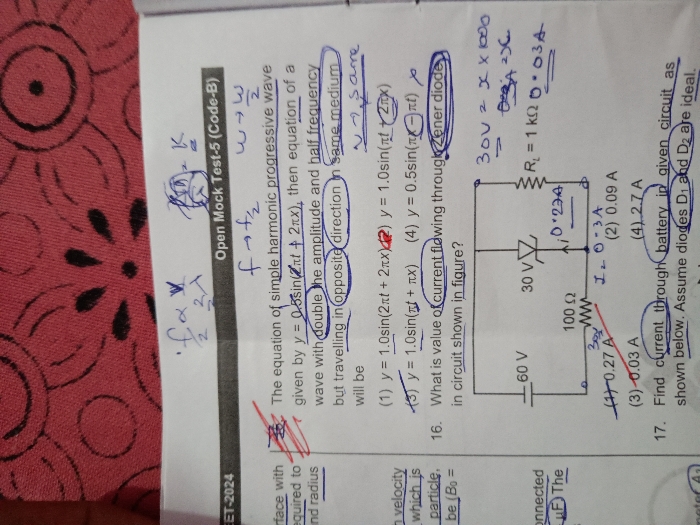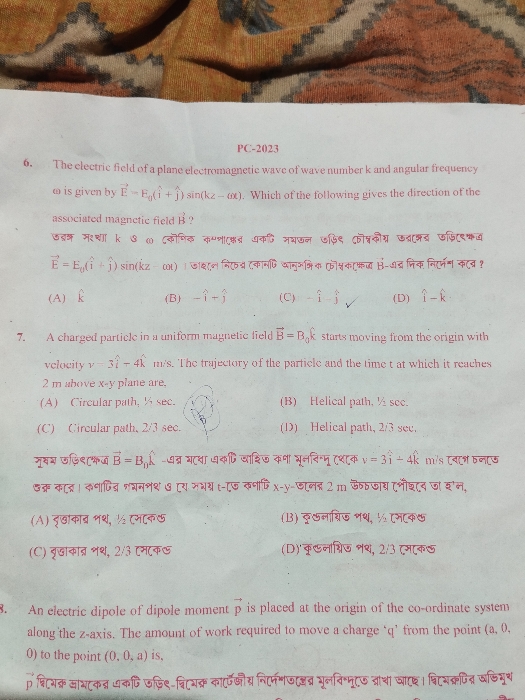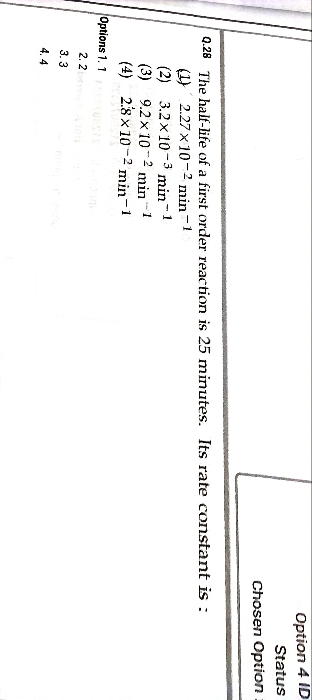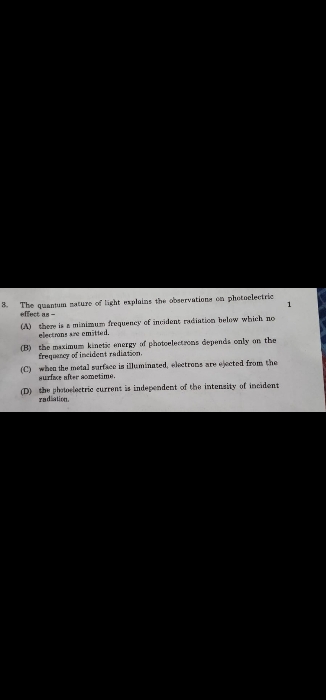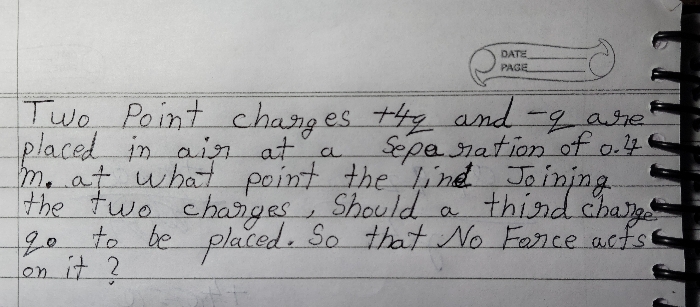CBSE Class 12-science Answered
Establish the formula of lens.
1/f=(meu-1)(1/R-1/R')
Asked by Ravishankarpoddar652 | 03 Jan, 2019, 09:22: AM
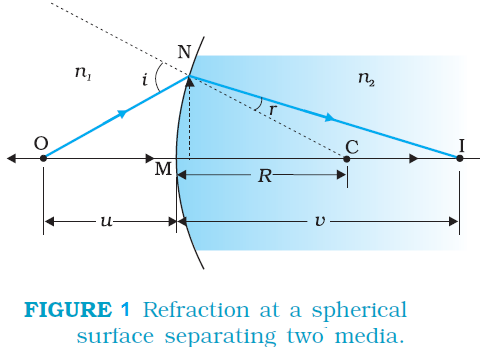
Figure 1 shows the geometry of formation of image I of an object O on the principal axis of a spherical surface with centre of curvature C,
and radius of curvature R. The rays are incident from a medium of refractive index n1, to another of refractive index n2.
We take the aperture (or the lateral size) of the surface to be small compared to other distances involved, so that small angle approximation
can be made. In particular, NM will be taken to be nearly equal to the length of the perpendicular from the point N on the principal axis.
We have, for small angles,
tan NOM = MN / OM , tan
NOM = MN / OM , tan  NCM = MN / MC , tan
NCM = MN / MC , tan  NIM = MN / MI
NIM = MN / MI
tan
 NOM = MN / OM , tan
NOM = MN / OM , tan  NCM = MN / MC , tan
NCM = MN / MC , tan  NIM = MN / MI
NIM = MN / MINow, for ΔNOC, i is the exterior angle. Therefore, i = ∠NOM + ∠NCM
i = (MN/OM) + (MN/MC) ......................................................................................................(1)
i = (MN/OM) + (MN/MC) ......................................................................................................(1)
Similarly, r = ∠NCM – ∠NIM, i.e., r = (MN/MC) - (MN/MI) ...............................................(2)
Now, by Snell’s law n1 × sin i = n2 × sin r or for small angles n1 × i = n2 × r
Substituting i and r from Eqs. (1) and (2), we get,  .............................................(3)
.............................................(3)
Here, OM, MI and MC represent magnitudes of distances. Applying the Cartesian sign convention,
 .............................................(3)
.............................................(3)Here, OM, MI and MC represent magnitudes of distances. Applying the Cartesian sign convention,
OM = –u, MI = +v, MC = +R
Substituting these in Eq. ( 3 ), we get
 .............................................................(4)
.............................................................(4)Equation ( 4 ) gives us a relation between object and image distance in terms of refractive index of the medium and the radius of
curvature of the curved spherical surface. It holds for any curved spherical surface.
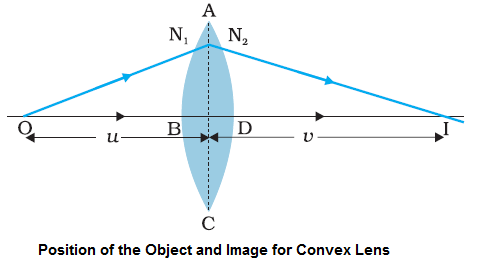
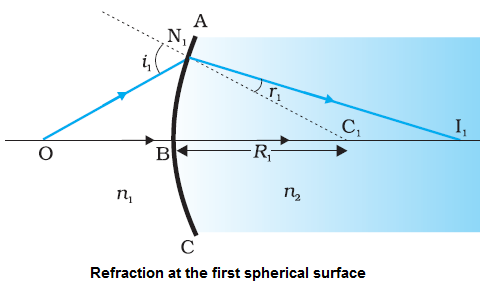
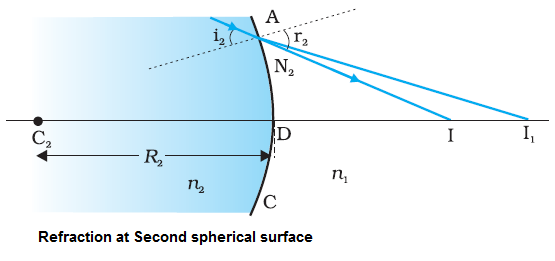
Left most Figure above shows the geometry of image formation by a double convex lens. The image formation can be seen in terms of two steps:
(i) The first refracting surface forms the image I1 of the object O [ middle figure]. The image I1 acts as a virtual object for the second surface
that forms the image at I [ Right most figure]. Applying Eq. (4) to the first interface ABC, we get
(i) The first refracting surface forms the image I1 of the object O [ middle figure]. The image I1 acts as a virtual object for the second surface
that forms the image at I [ Right most figure]. Applying Eq. (4) to the first interface ABC, we get
 .............................(5)
.............................(5)A similar procedure applied to the second interface ADC gives,
 ..............................(6)
..............................(6)Note that now the refractive index of the medium on the right side of ADC is n1, while on its left it is n2.
Further DI1 is negative as the distance is measured against the direction of incident light.
For a thin lens, BI1 = DI1. Adding Eqs. (5) and (6), we get
 ..........................(7)
..........................(7)Suppose the object is at infinity, i.e., OB → ∞ and DI = f, Eq. (7) gives
 .......................................(8)
.......................................(8)The point where image of an object placed at infinity is formed is called the focus F, of the lens and the distance f gives
its focal length. A lens has two foci, F and F′, on either side of it . By the sign convention,
BC1 = + R1, DC2 = –R2 and we have 

So Eq. (8) can be written as  .......................(9)
.......................(9)
Equation (9) is known as the lens maker’s formula. It is useful to design lenses of desired focal length using surfaces
of suitable radii of curvature. Note that the formula is true for a concave lens also. In that case R1is negative, R2 positive and
therefore, f is negative.
 .......................(9)
.......................(9)Equation (9) is known as the lens maker’s formula. It is useful to design lenses of desired focal length using surfaces
of suitable radii of curvature. Note that the formula is true for a concave lens also. In that case R1is negative, R2 positive and
therefore, f is negative.
Answered by Thiyagarajan K | 03 Jan, 2019, 04:43: PM
Concept Videos
CBSE 12-science - Physics
Asked by kulhariabhijeet | 21 Apr, 2024, 02:39: PM
CBSE 12-science - Physics
Asked by mohapatraswetalina88 | 21 Apr, 2024, 12:18: PM
CBSE 12-science - Physics
Asked by aishaisha091098 | 19 Apr, 2024, 04:54: PM
CBSE 12-science - Physics
Asked by dasrituparna1999 | 13 Apr, 2024, 06:56: AM
CBSE 12-science - Physics
Asked by dasrituparna1999 | 12 Apr, 2024, 09:26: PM
CBSE 12-science - Physics
Asked by mishrigupta19319 | 08 Apr, 2024, 06:28: PM
CBSE 12-science - Physics
Asked by madhav9119887644 | 07 Apr, 2024, 08:10: PM
CBSE 12-science - Physics
Asked by mishrigupta19319 | 07 Apr, 2024, 11:23: AM
CBSE 12-science - Physics
Asked by adityagalar2007 | 06 Apr, 2024, 01:06: PM






